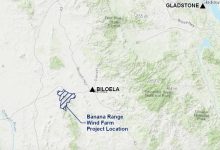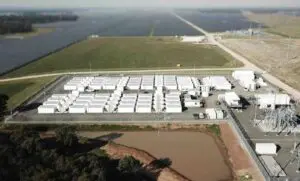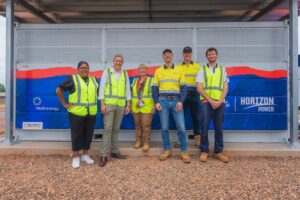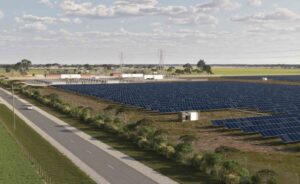The Queensland state government has given development approval to a new 180MW wind project near Biloela that may also include a big battery.
The development approval for Lacour Energy’s Banana Range wind farm was announced on Sunday by state planning minister Cameron Dick and energy minister Anthony Lynham, who said it took the number of wind projects in the state – built or under construction or in the pipeline – to more than 2,200MW.
The state’s first large scale wind farm, the 170MW Emerald facility, was completed earlier this year while another, the 450MW Cooper’s Gap facility is producing but not yet complete.
“Besides the great environmental benefits for Queensland, investment in projects such as this also creates a flow-on economic effect for local businesses and assists in diversifying the town’s economy,” Dick said in a statement.
Lacour director James Townsend said the Banana Range wind farm would produce most of its electricity at night, and so would complement the day time energy from rooftop solar and the solar farms which have recently been built in Queensland, and which have been pushing prices into negative territory on repeated occasions.
“The area is known for its strong night-time winds which is when the wind farm will produce the most energy, and this means the project is very complementary to the daytime energy from rooftop solar and the solar farms that have recently been built in Queensland,” he said in a statement.
“The onsite powerline and excellent wind resource mean that the project can supply competitively priced electricity.”
Townsend said there is still more work to complete before feasibility is completed, but if the feasibility is successful, the company plans to begin construction towards the end of next year, and it would be in operation by the end of 2022. He told RenewEconomy its advantage lay in being close to the grid and having an excellent wind resource.
Lacour also did the initial development of the huge 800MW Clarke Creek wind project, with battery storage and a possible neighbouring solar farm, and has brought in Goldwind as development partner. It has been one of 10 projects shortlisted for possible contracts by the new CleanCo state generator that begins operations at the end of this month.
Lynham said the project adds to a pipeline of around 18,000MW of large scale renewable capacity that is at the early state of development, but few new projects have reached the state of financial commitment.
“Queensland has more than 2370 megawatts of large‑scale renewable energy capacity operating already and another 250 committed or under construction,” Lynham said. (See our story on Friday for a list of those projects).
“Around 18,000 megawatts more of large-scale renewable capacity is currently at earlier stages of development,” Lynham said.
However, the powerful Electrical Trades Union has called for a stop to all new wind and solar farm development until the state government can outline a “just transition” plan for electricity industry workers, particularly in regional areas.
However, as Lynham’s comments reveal, only around 250MW of the 18,000MW in the pipeline has been committed as project developers wait for clarity around the state of the electricity market, connection rules and the market design.
Ironically, the union concerns were prompted by reports of the early closure of the Callide B power station, also near Biloela. It is not due to close until the early 2030s, and employs around 220 people – although that includes the more modern Callide C plant which will likely last longer.
The $250-$350 million Banana Range wind project will be located about 20kms west of Biloela and 120kms south west of the port of Gladstone, will involve up to 50 wind turbines, possible battery storage and will create up to 150 jobs during construction and up to 15 full time jobs during operations.
Lacour estimates it will inject $30-$40 million into the regional economy during construction and Townsend also said the project would provide a $100,000-a-year community benefits fund for projects or initiatives within the nearby communities over the life of the project..










